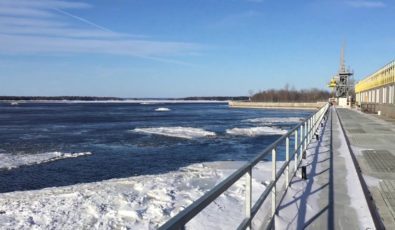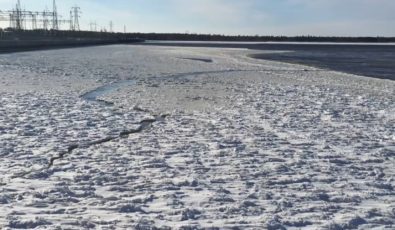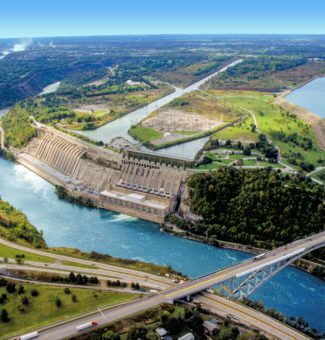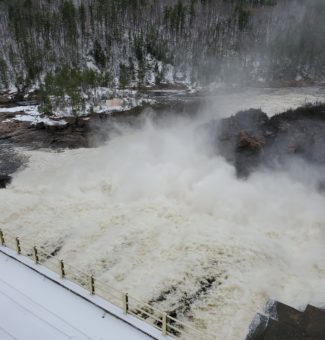OPG’s hydro operations not frazzled by frazil ice
During this time of year, a specific type of ice threatens to wreak havoc on OPG’s hydro operations and the province’s river systems.
The culprit? A sticky, slushy collection of loose, random ice called frazil ice.

This type of ice forms and multiplies quickly in supercooled waters – when water and air temperatures suddenly plunge amid turbulent or windy conditions. It can appear on the surface as slush or sharp finger-like ice crystals, but most often frazil ice will sink underwater, where it can do the most damage.
At OPG’s hydro operations, frazil ice can quickly gum up water intakes and generating units, threatening reliable power production. And in certain river systems, too much frazil ice build up can lead to flooding concerns for communities.
“Frazil ice will turn a generator into a Slurpee machine and grind it to a stop,” said Corey Squires, a Trades Management Supervisor at Chats Falls Generating Station (GS). “The entire unit will freeze up, and there’s lots of potential issues if it’s not caught early.”
To mitigate frazil ice formation, OPG’s hydro operators and water managers promote the formation of an even ice cap on the waters around the company’s hydro operations. This is done by managing water levels and flows and temporarily shutting units down for a short period until an ice cap has formed.
“Frazil ice will turn a generator into a Slurpee machine and grind it to a stop. The entire unit will freeze up, and there’s lots of potential issues if it’s not caught early.”Corey Squires, Trades Management Supervisor at Chats Falls GS
The smooth ice cap can act as an insulator, helping to prevent the formation of frazil ice by stopping the intermixing of cold air and water. The ice cap also allows for unimpeded, efficient flows under the ice.
In eastern Ontario, a milder winter and wide temperature fluctuations have prevented the proper formation of an ice cap at some sites, resulting in an unusual amount of frazil ice.

At Chats Falls GS, for instance, an extreme amount of frazil ice in December and January resulted in several units being taken offline. Upstream of the station, which straddles the Ontario-Quebec border on the Ottawa River, conditions have been ripe for frazil ice this year, with high velocity, shallow waters mixing with cold air.
“Once we’re in an emergent situation where we’ve lost generation because of the ice, that’s where our team of technicians will come into play to free up the ice accumulation,” said Squires. “We will work with the hydro operations group to open up automatic sluicegates to try to sweep out the ice and flush it away from the station, or set our units to generate at low levels to spit out the ice that way.”
The situation has since improved with more consistent temperatures and the formation of ice cover in the station’s headpond.
Chats Falls has also taken other measures over the years to prevent frazil ice from interfering with units. That includes converting the trash racks that screen the water intakes from ice-attracting steel to plastic PVC, which more easily sheds ice.
Meanwhile, in the province’s northwest, water flows have to be managed carefully to prevent frazil ice formation that could lead to flooding impacts for the community.
“It’s a tricky balancing act,” said Tom Aaltomaa, a First Line Manager of Operations in OPG’s Northwest Operations, who helps monitor production from 11 OPG hydro stations in the region. “If we stray out of certain flow regimes, and the flow gets too high, we might create too much frazil ice, which can cause flooding.”
In this region, frazil ice can pose a problem at OPG’s Kakabeka GS on the Kaministiquia River, as well as in a section of the river downstream of the plant. The steepness of this stretch of river can increase the velocity of flows, increasing the potential for frazil ice to form and potentially impacting the nearby Fort William Historical Park with flooding.
The key to managing frazil ice is to maintain the flow within specific ranges in the early months of winter to reduce the formation of frazil ice and promote the development of an even ice cap. Once the ice cap is in place, flows are managed to minimize fluctuations in the river to avoid breaking up the cap, Aaltomaa said.
Managing the river’s flows to maintain proper ice cover takes constant finessing by OPG’s water managers. In Northwest Ops, this includes moderating the amount of water released from the Dog Lake reservoir upstream of the Kaministiquia River, while balancing the needs of power generation and ensuring the reservoir is at an appropriate level by the spring to accommodate the freshet.
On larger bodies of water near OPG sites, like the St. Lawrence River, Lake Erie, and Niagara River, expansive steel and wood ice booms are installed in the late fall and early winter to help facilitate the formation of a natural ice cover.
When made properly, the ice cover is smooth to mitigate turbulence and insulate the surface water temperatures. In addition to preventing frazil ice from forming, these ice booms can help prevent larger chunks of ice from travelling down the rivers and causing damage to OPG stations in these regions, which include R.H. Saunders GS and the Sir Adam Beck facilities.
The ice booms also have the added benefit of reducing resistance in the river’s flows, resulting in more efficient power generation, and they also help promote the even breaking of ice in the spring months, when the ice booms are lifted.
Subscribe and stay informed
Sign up to receive the latest news, project updates, and event information from OPG.


